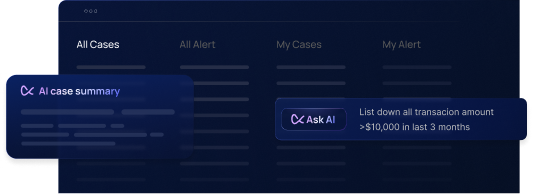As the fintech and neobank industries continue to grow, so do the risks of financial crime and fraud. Money laundering, terrorist financing, and other illicit activities pose significant threats to the integrity of financial systems, and regulatory agencies around the world are stepping up their efforts to prevent and detect these crimes.
One crucial tool in the fight against financial crime is the Suspicious Activity Report (SAR). SARs are filed by financial institutions to alert regulatory agencies of suspicious transactions or activities that may be indicative of money laundering, terrorist financing, or other illicit activities.
For fintechs, digital banks and neobanks, which operate in a highly digitized and rapidly changing landscape, it can be challenging to stay on top of the latest regulatory requirements and best practices for SAR filing.
In this article, we'll dive into the world of SARs and provide a comprehensive guide to protecting your fintech or neobank from fraud. We'll cover what SARs are, the best practices for filing effective SARs, and also discuss the SAR filing process.
What are suspicious activity reports?
A Suspicious Activity Report (SAR) is a report that financial institutions file with regulatory agencies to report suspicious transactions or activities that may indicate money laundering, terrorist financing, or other illicit activities. SARs play a critical role in detecting and preventing financial crime, and they are required by law in many countries.
SARs can cover a wide range of activities, such as transactions involving large sums of money, unusual patterns of transactions, or transactions involving high-risk customers or countries. SARs can also be filed for non-transactional activities, such as attempts to open an account using fraudulent identification or suspicious behavior by a customer or employee.
In the United States, SARs are filed with the Financial Crimes Enforcement Network (FinCEN), which is part of the U.S. Department of the Treasury. FinCEN is responsible for collecting and analyzing SARs and other financial intelligence to combat financial crime. Other countries have similar regulatory agencies that collect SARs and analyze financial intelligence to detect and prevent financial crime.
Financial institutions are required by law to file SARs when they detect suspicious activity. Failure to file SARs can result in fines, penalties, and even criminal charges. By filing SARs, financial institutions can help law enforcement agencies identify and prosecute financial criminals, protect their customers and shareholders, and demonstrate their commitment to regulatory compliance and financial integrity.
Best practices for filing SARs
Filing an effective SAR requires a clear understanding of the suspicious activity, regulatory requirements, and best practices for SAR filing. Here are some best practices for writing SARs that can help financial institutions detect and prevent financial crime:
- Be specific and detailed: SARs should be specific and detailed, avoiding vague or ambiguous language that could be misinterpreted. Provide as much information as possible about the suspicious activity, including what happened, when it happened, and why it was suspicious.
- Relevant customer information: The SAR should include relevant information about the customer or entity involved in the suspicious activity, such as name, address, account number, and any other identifying information. The information should be accurate and up-to-date to help law enforcement agencies identify the suspect and prevent future suspicious activity.
- Use standard terminology: Use standard terminology and abbreviations when referring to suspicious activity or other relevant information. This can help ensure consistency and clarity across different SARs and regulatory agencies.
- Provide supporting documentation: Include supporting documentation that helps explain or corroborate the suspicious activity, such as transaction records, account statements, or communication logs. The documentation should be organized and clearly labeled to help law enforcement agencies understand the context of the suspicious activity.
- Follow regulatory guidelines: Follow the regulatory guidelines for SAR filing in your country or region, including any specific reporting requirements or deadlines. Failure to comply with these guidelines can result in fines, penalties, and other legal consequences.
- Conclusion or recommendation: The SAR should conclude with a clear and concise recommendation for how to proceed, such as whether to terminate the customer relationship, freeze the account, or conduct further investigation. The recommendation should be based on the facts and circumstances of the suspicious activity and should be supported by the evidence presented in the SAR.
- Train staff on SAR filing: Train staff on the requirements and best practices for SAR filing, including how to identify and report suspicious activity, how to document the activity, and how to file a SAR. This can help ensure consistency and accuracy across different SARs and staff members.
- Continuously review and update SARs: Continuously review and update SARs to reflect new information or changes in the suspicious activity. This can help ensure that SARs remain relevant and effective in detecting and preventing financial crime.
By following these best practices, financial institutions can file effective SARs that help detect and prevent financial crime, protect their customers and shareholders, and demonstrate their commitment to regulatory compliance and financial transparency.
SAR filing process
The SAR filing process involves several steps that financial institutions must follow to comply with regulatory requirements and help detect and prevent financial crime. Here is a general overview of the SAR filing process:
Step 1: Identify suspicious activity
The first step in the SAR filing process is to identify suspicious activity that may require a SAR. This may involve monitoring customer transactions, reviewing account activity, or conducting due diligence on new customers or transactions.
Step 2: Document the suspicious activity
Once suspicious activity is identified, it should be thoroughly documented using clear and concise language. This documentation should include relevant details such as what happened, when it happened, and why it was suspicious.
Step 3: Review and assess the suspicious activity
After documenting the suspicious activity, it should be reviewed and assessed by an experienced and knowledgeable staff member. This review should determine whether the activity meets the regulatory requirements for SAR filing and whether additional investigation or analysis is needed.
Step 4: Prepare and file the SAR
If the suspicious activity meets the regulatory requirements for SAR filing, the SAR should be prepared and filed with the relevant regulatory agency. This may involve completing a specific SAR form or using an electronic filing system, depending on the regulatory requirements in your country or region.
Step 5: Maintain SAR records
After filing the SAR, financial institutions must maintain accurate and complete records of all SARs filed. These records should include the SAR itself, any supporting documentation, and any correspondence with regulatory agencies or law enforcement.
Step 6: Follow up and review
Finally, financial institutions should follow up on any SARs filed to ensure that appropriate action has been taken, and review their SAR filing process regularly to identify any areas for improvement.
By following these steps, financial institutions can comply with regulatory requirements for SAR filing and help detect and prevent financial crime. However, it is important to note that the SAR filing process can vary depending on the specific regulatory requirements in your country or region. Therefore, financial institutions should consult with their legal and compliance teams to ensure that they are following the appropriate SAR filing process.
Conclusion
Protecting your fintech or neobank from fraud requires a comprehensive approach that includes real-time monitoring, customer risk assessment, ID verification, sanctions screening, and SAR filing. By implementing best practices for SAR filing, financial institutions can comply with regulatory requirements and help detect and prevent financial crime.
Furthermore, financial institutions can leverage technology to streamline their SAR filing process, improving the accuracy and efficiency of SAR detection and reducing the time and resources required for SAR filing and maintenance.
Flagright is a global provider of AML compliance and fraud protection solutions for fintechs and neobanks. With a platform designed to help financial institutions of all sizes stop financial crime, secure their payments, and navigate the complex landscape of regulatory compliance, all while offering the industry's fastest integration time of just 4 days on average.
To learn more about Flagright and how we can help your fintech or neobank stay compliant and secure, contact us to schedule a free demo here.
About the Author
Joseph Ibitola leads global demand generation at Flagright, an AI-native transaction monitoring and AML compliance platform. He drives marketing strategy, campaigns, and growth initiatives that help financial institutions adopt stronger compliance frameworks and reduce fraud risk. With expertise spanning fraud prevention, AML compliance, and financial risk management, Joseph also develops thought leadership and educational resources that position Flagright as a trusted partner to the finance industry.




.svg)





















